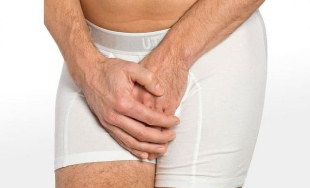
In men, prostatitis is an inflammation of the male prostate gland. It is a relatively common condition in men, accompanied by pain when emptying the bladder (urination) and during ejaculation. Doctors distinguish between acute and chronic prostatitis. Therapy and prognosis depend on the form and causes of prostatitis. Read all about prostatitis here.
Prostatitis: description
Prostatitis (inflammation of the prostate gland) is an inflammation of the human prostate gland. It is located just below the prostate gland and is the size of a chestnut. It covers the first part of the urethra and extends to the so-called pelvic floor, which is made up of muscles.
The prostate produces a secretion that contains PSA (prostate-specific antigen) and sperm. PSA makes discharge more subtle. Sperm are important for sperm motility.
Prostatitis is mainly associated with severe pain in the perineum and anal region. In addition, inflammation of the prostate can cause symptoms such as urinary frequency, pain when urinating (ejaculation), and pain during ejaculation.
Inflammation of the prostate gland is relatively common. It is estimated that about 15 percent of all men in Germany develop prostatitis once in a lifetime. The likelihood of prostate narrowing increases with age. Studies show that most people are between 40 and 50 years old.
Prostatitis Syndrome
At the same time, a broad understanding of the term prostatitis has emerged in medicine. Several complaints in the pelvic region of a person with so-called prostatitis syndrome usually have an unknown cause. The term "prostatitis syndrome" summarizes the various clinical features:
- Acute bacterial prostatitis
- Chronic bacterial prostatitis
- Inflammatory and non-inflammatory syndrome of chronic ventricular pain ("Bacterial chronic prostatitis")
- Asymptomatic prostatitis
Acute and chronic bacterial prostatitis
Acute prostatitis is caused by bacteria (acute bacterial prostatitis). Bacteria either enter the prostate through the bloodstream or spread to the prostate from a bacterial infection of the bladder or urethra. Acute prostatitis is a severe general condition with severe pain, usually during urination, fever and chills. Inflammation of the prostate gland is caused by bacteria in about ten percent of cases.
Chronic prostatitis can develop acutely: if inflammation of the prostate gland and recurrent germs in the urine, called prostate (obtained by massaging the prostate fluid), or discharge is observed for more than three months, it is chronic inflammation. bacterial prostatitis. It is less lightning fast than acute prostatitis. Although chronic inflammation of the prostate gland causes pain when urinating and possibly a feeling of pressure in the perineal area, the symptoms are generally not as severe as in acute prostatitis.
Chronic ventricular pain syndrome (abacterial prostatitis)
In most cases of prostate infection, bacteria cannot be detected as the cause of the disease during urination, prostate or ejaculation. The trigger for prostatitis is unknown. Doctors call this chronic pelvic pain syndrome (chronic abacterial prostatitis).
However, in such cases, leukocytes (leukocytes) often appear in the form of inflammation of the prostate gland (chronic pelvic pain syndrome). Another form of the disease is the absence of bacteria and leukocytes to differentiate (non-inflammatory chronic pelvic pain syndrome). In general, chronic pelvic pain syndrome (abacterial prostatitis) is the most common form of prostatitis.
Asymptomatic prostatitis
Rarely, asymptomatic prostatitis occurs. Although there are signs of inflammation in this form of prostatitis, there are no pain or other symptoms. Asymptomatic prostatitis is usually detected by chance, for example, as part of a fertility study.
Prostatitis: symptoms
Inflammation of the prostate can cause various symptoms of prostatitis. The symptoms of acute prostatitis can be very severe and cause serious concern, but with chronic prostatitis they are generally mild. Not all of these symptoms are necessarily present in every affected person, and the severity of the symptoms may vary from person to person.
Acute prostatitis: symptoms
Acute prostatitis is an acute condition in which patients often suffer from fever and chills. Inflammation of the prostate gland around the urethra also causes typical urinary symptoms. The bladder causes burning pain (alguria) and a significant decrease in urine flow due to prostate swelling (dysuria). Victims have a constant urinary frequency and have to go to the toilet frequently (pollakisuria) because they can only urinate in small amounts. Other symptoms of prostatitis include bladder, pelvic pain and back pain. Pain can occur during or after ejaculation.
Chronic prostatitis: symptoms
Chronic prostatitis usually causes less severe symptoms than acute prostatitis. Symptoms such as fever and chills are generally absent. Symptoms such as a feeling of pressure in the perineum or lower abdomen, darkening of the discharge due to blood in the semen, or blood in the urine (hematuria) are typical of chronic inflammation of the prostate. Sexual drive and potency disorders are also common chronic symptoms often caused by pain during or after ejaculation. The symptoms of chronic bacterial and chronic abacterial prostatitis (chronic pelvic pain syndrome) do not differ.
How to recognize?

The onset of prostatitis is rarely unambiguous, as it is sometimes asymptomatic and the symptoms are individual to each patient and change over time.
These features include:
- A person has some difficulty urinating in the toilet. The pancreas gradually grows, the urethra narrows.
- The patient loses interest in sex. The difficulty of waking up the penis increases when trying to have sex. Orgasm is difficult to achieve or weakens or disappears completely.
- Burning in the urethra, itching in the perineum.
- I want to urinate often, but I take drops by drop.
- The breast comes out quickly when in contact with minimal pleasure.
- General fatigue, depression, nervousness, aggression, anxiety increase.
In the morning, a person loses consciousness and loses initiative in life.
At the same time, prolonged erections and painful ejaculation sometimes occur spontaneously at night, not related to sex.
By observing these events, the patient believes that the potential is good, the problems are related to the partner, the relationship. Eliminates depression, which aggravates the development of the disease.
Disease statistics
Prostatitis is one of the most common diseases of the male genitourinary system in the world. According to various sources, sex is observed in 60-80% of adult men. According to official medical statistics, more than 30% of young people of reproductive age suffer from chronic prostatitis. About a third of cases occur in men over the age of 20 and over the age of 40. According to the WHO, urologists diagnose chronic prostatitis in every tenth patient.
Complications of prostatitis
In addition to acute symptoms, prostatitis can lead to complications that complicate the course of the disease and prolong recovery. The most common complication is prostate abscess (especially in acute bacterial prostatitis). An abscess of the prostate is an inflammatory inflammation that usually needs to be opened with an incision and emptied.
As another complication of prostate inflammation, the inflammation can spread to nearby structures such as the epididymis or testis (epididymitis, orchitis). It is also suspected that chronic prostatitis is associated with the development of prostate cancer.
Prostatitis: causes and risk factors
Prostatitis can have different causes. Treatment and prognosis of inflammation depends on the cause of prostatitis.
Bacterial prostatitis: cause
Only ten percent of prostatitis cases are caused by bacteria (bacterial prostatitis). Bacteria can cause an inflammatory reaction in the prostate blood (hematogen) or from nearby organs such as the bladder or urethra.
Escherichia coli (E. coli), which mainly occurs in the human intestine, is the most common cause of prostatitis. Klebsiella, enterococci or mycobacteria can also cause prostatitis. Bacterial prostatitis can also be the result of sexually transmitted diseases such as chlamydia or Trichomonas infection and gonorrhea.In chronic prostatitis, the bacteria in the prostate gland get rid of an as yet unknown way to protect the human immune system. This allows germs to constantly colonize the prostate. Antibiotics are relatively weak in prostate tissue, which may be another reason why bacteria live in the prostate.
Chronic pelvic pain syndrome: causes
The exact causes of chronic pelvic pain syndrome are not yet fully understood. Scientists have put forward many theories, each of which sounds plausible, but not all of them have been proven. In some cases, genetic material of previously unknown microorganisms was found in the small pelvic region. Therefore, the cause of pelvic pain syndrome may be microorganisms that cannot yet be grown in the laboratory and therefore cannot be detected.
Another possible cause of chronic pelvic pain syndrome is bladder emptying. Bladder volume increases due to impaired drainage, which puts pressure on the prostate. This pressure eventually damages the prostate tissue, causing inflammation.
Another possible cause is the spread of inflammation of the bladder tissue to the prostate gland.Irritation of the nerves around the prostate can also cause pain that is mistaken for the prostate gland.
Finally, it is possible that an excessive or incorrect immune system can cause chronic pelvic pain syndrome.
However, in many cases the cause of chronic ventricular pain cannot be clearly stated. Then doctors talk about idiopathic prostatitis.
Anatomical causes
Rarely, prostatitis is caused by narrowing of the urinary tract. If the urinary tract narrows, urine collects and enters the prostate, it can also cause inflammation. This contraction can be caused by tumors or so-called prostate stones.
Doctors also suspect that dysfunction of the pelvic floor muscles may contribute to the development of prostatitis.
Mental Causes
Recently, more and more psychological causes of prostatitis are being discussed. In particular, there is a possibility of a mental strike in non-inflammatory chronic pelvic pain syndrome. The exact mechanisms are not yet known.
Prostatitis risk factors

Some men are especially at risk for developing a prostate infection. These include, for example, men with a compromised immune system or a suppressed immune system (for example, with medication, immunosuppressive therapy). In addition, major diseases such as diabetes can contribute to the development of prostatitis: high blood sugar in diabetics leads to an increase in urinary sugar. High levels of sugar in the urine can promote good growth of bacteria, which facilitates the development of urinary tract infections. In addition, diabetes weakens the immune system.
Another risk factor in the development of prostatitis is the bladder catheter. The passage of a catheter from the urethra to the urethra can cause small tears in the urethra and damage to the prostate gland. In addition, as in any foreign body, bacteria can settle on the bladder and form a so-called biofilm. As a result, the bacterium can travel from the urethra to the bladder and cause a prostate infection.Prostatitis: examination and diagnosis
Your family doctor or urologist is the person who communicates properly with your prostate problems. The general practitioner may take a medical history (date), but if prostatitis is suspected, you will be referred to a urologist. It conducts a physical examination. If prostatitis is suspected, it is usually a digital rectal examination. However, this study does not provide clear evidence of prostatitis, but only confirms the suspicion. Laboratory tests can be done to detect bacterial prostatitis. Unless a specific cause is found, treatment is also given when prostatitis is suspected.
Case history
Typical questions may occur when recording a medical history:
- Do you have pain when urinating?
- Where exactly do you feel pain?
- Does your back hurt?
- Did you see a change in the discharge?
Digital rectal examination
Because the prostate gland is directly adjacent to the rectum, it can be palpated along the rectum. This digital rectal examination is performed in an outpatient setting and without anesthesia and is generally painless. The patient is asked to lie down with his legs bent. Using a lubricant, the doctor then slowly inserts a finger into the anus and scans the prostate and surrounding organs (palpation). Investigates the size and sensitivity of pain in the prostate gland: an inflamed prostate gland is greatly enlarged and very sensitive to pain.
Laboratory examination
Urine analysis is often performed to identify possible pathogens. The standard method is the so-called four-bottle sample. Here Ersturin, Mittelstrahlurin, Prostataexprimat and Urin are tested after prostate massage. Because it is called prostatexprimat, doctors call it prostate secretion. The doctor does this by applying gentle pressure to the prostate, for example by palpation. Ejaculation can also be checked for pathogens and signs of inflammation.
Additional Research
Ultrasound examination of the rectum (sonography) can be used to determine the exact location and extent of inflammation. An important goal of the study is to prevent other diseases with similar symptoms (differential diagnosis).
Uroflowmetry is performed to rule out the presence of an existing urinary problem as a result of narrowing of the urethra. The patient urinates in a special funnel that measures the amount of urine per unit time. Normal urine flow is 15-50 milliliters per second, and even if the urine flow is ten milliliters per second or less, there is a high probability of urethral obstruction.
Prostatitis: PSA measurement
High blood PSA (prostate-specific antigen) levels are generally considered an indicator of prostate cancer. However, even with prostatitis, PSA levels in the blood can be significantly increased. If the reading is significantly elevated, a tissue sample (biopsy) is usually taken and examined in a laboratory to reliably rule out prostate cancer.
Prostatitis: Treatment
As with other diseases, the treatment and duration of prostatitis depends on the cause.
Medication
Acute bacterial prostatitis is treated with antibiotics. In mild cases, the antibiotic dose is sufficient for ten days. For chronic prostatitis, the drug should be taken for a longer period (about four to six months). Even if symptoms subside, antibiotics should be continued as prescribed by your doctor. This prevents relapse and reduces the likelihood of relapse.
Asymptomatic prostatitis can also be treated with antibiotics.
If you have chronic bacterial prostatitis (chronic pelvic pain syndrome), antibiotic therapy is generally ineffective. Although there is no evidence of a pathogen in chronic pelvic pain syndrome, antibiotic testing is performed because sometimes improvement can also be made. However, antibiotic therapy is not recommended for anti-inflammatory chronic pelvic pain syndrome.
xxx If no improvement is achieved, drug therapy will be supplemented with physiotherapy. It is recommended to do physical therapy, pelvic floor exercises or regular prostate massage. In addition, microwave heat therapy can stimulate tissues to increase blood flow and reduce pain.In addition, symptomatic therapy can help relieve the acute symptoms of prostate infection. Painkillers can be prescribed for severe pain. Also, heat pads and heating pads on your back or lower abdomen can help relax your muscles. Often relieves pain from inflammation of the prostate.
Home remedies such as rye processing or eating soft-shelled pumpkin seeds can also help with prostatitis symptoms. Other recommendations include regular pelvic floor exercises, a sharp bicycle saddle and no beer, meat, fat or sugar.
Treatment of complications
In the context of the disease, prostatectomy can help prevent massive urinary incontinence because residual urine is always at risk of urinary tract infection.
If the prostate gland is inflamed (abscess), it should be emptied with an incision. The route of entry is generally the rectum.
























